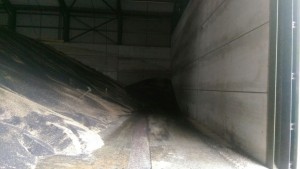At around 6:30 a.m., in a silo, thick smoke was detected coming from the grain flake and dust waste storage facility next to a horizontal silo containing rapeseed. The fire brigade sprayed down the pile in the premises. The operator used the machinery on site to remove 100 t of waste from the silo, including 30 to 50 t of blackened waste, which was allowed to cool down outside. High CO levels were detected in the handling tower and adjacent premises, and a ventilation system was installed. Increasing temperatures were detected on the walls of the adjacent silo, which was then emptied as a preventive measure in the event of self-heating. Under surveillance, the emergency services removed 1,200 tonnes of rapeseed and transferred it to a vertical silo. The wave of heat coming from the waste storeroom was conveyed to the adjacent horizontal silo, although no hot spot had been generated.
The fact that the silo had not been cleaned out for several months was determined to be the primary cause of the dust self-heating phenomenon. No emptying schedule for this silo had been defined. The schedule depends on the availability of the service provider assigned to remove the dust. Excessive dust levels had also been found in other installations, which may have resulted in another accident.
The inspection authorities for classified facilities required that the operator define a schedule for complete emptying of the silo and to clean its installations. The operator also proposed to study the installation of temperature sensors in the waste storage room and modified its safety and operating instructions to stipulate that the silo be emptied at regular intervals.




